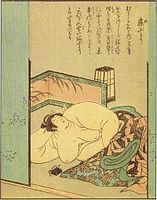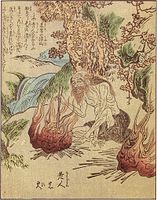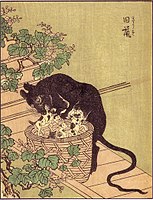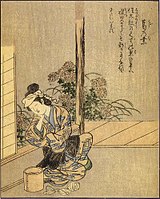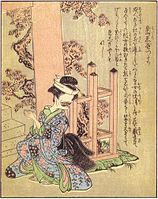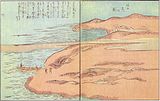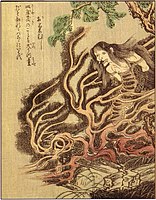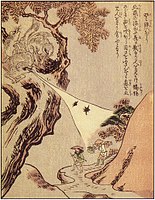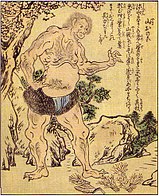User:Caracal-eyes/sandbox/Drafts/Ehon Hyaku Monogatari
| This is not a Wikipedia article: It is an individual user's work-in-progress page, and may be incomplete and/or unreliable. For guidance on developing this draft, see Wikipedia:So you made a userspace draft. Find sources: Google (books · news · scholar · free images · WP refs) · FENS · JSTOR · TWL |
Translation of the Japanese-language Ehon Hyaku Monogatari page, to be used to supplement the existing English-language stub.
Outline
[edit]The author is Tōsanjin (桃山人) (however, in the preface the author's name is written Tōka Sanjin [桃花山人]. According to the Kokusho Sōmokuroku (Iwanami Shoten) this is considered to be a gesaku author from the latter half of the Edo period, Tōkaen Michimaro (桃花園三千麿).
The illustrator is Takehara Shunsensai. Woodblock-printed books on yokai in the Edo period used only a main block to print black lines, or diluted ink printed repeatedly with a main block. One of the features of this book, besides using many printings of diluted ink, is that it used multicolored printing, with multiple color blocks in green, blue, and red ink.
It can be said that this is a kind of hundred-tale kaidan (ghost story) book popular in the Edo period, as "100 Tales" is part of the tile, but rather than being tales with story titles, yōkai names are printed on illustrations of yōkai, so it could be said that this work is a fusion of kaidan book and picture book.
It is also known by the title Tōsanjin Yawa (桃山人夜話, literally "Tōsanjin's Night Tales") because the title on the first page of each volume is "Tōsanjin Yawa, Volume [#]." Scholar of Japanese manners and customs Ema Tsutomu (Nihon Yōkai Henka-shi, 1923) and folklorist Fujisawa Morihiko (Hentai Densetsu-shi, 1926), as well as magazines at that time, introduced this book by the name Tōsanjin Yawa, and so this title became famous. On the other hand, Mizuki Shigeru, in his 1979 Yōkai 100 Monogatari describes it in his references as "Ehon Hyaku Monogatari (Author: Tōsanjin, Year of publication: Unknown)."
It has also been recognized that a book with completely the same contents, titled Ehon Kaidan Zoroe, was published in 2005 by Yumoto Kōichi. The preface's title is changed, and the title of each volume is Ehon Kaidan Zoroe Volume [#] rather than Tōsanjin Yawa Volume [#]. Upon examination, it appears to be an earlier publication than Ehon Hyaku Monogatari, with the relationship that the inscriptions of "Tōsanjin" and "Tōka Sanjin" are mixed, and it also is generally suggested that the first edition of Ehon Hyaku Monogatari may have been published before 1841.
Collected Works
[edit]The illustrations have been numbered by volume and appearance order. For example, the second image of the fourth volume would be 4-2.
The translation for the text in each image is given below the corresponding illustration number and yōkai name.
First Volume
-
1-1
-
1-2
-
1-3
-
1-4
-
1-5
1-1 (First, Hakuzōsu) “Hakuzōsu is also a key figure of kyōgen and well known, so the story is omitted here."
1-2 (Second, **Hinoenma**) “She may be beautiful, but she is very frightening, night after night appearing to suck men's lifeblood and vitality, eventually killing them."
Note: The text states that hienma originates from a Buddhist term, hienma-enshō-nyo (飛縁魔縁障女).
1-3 (Third, ***Kowai*** (狐者異)) In the main text, it is said that after the death of a thoughtless person, their obstructive thoughts (mōnen) take form, and this is said to be an existence that disturbs Buddhist law. Also, “kowai” (怖い, meaning “scary”) is said by folk etymology to come from this.
1-4 (Fourth, ***Shio-no-Chōjirou*** “One who kills a domesticated horse often becomes a chōjirō, cursed by the horse they killed, and the horse's spirit constantly goes in and out of their mouth. and a horse’s ghost is constantly coming and going from the mouth. This has been told in various ways from long ago."
1-5 (Fifth, Isonade) "There are many in the ocean of western Japan. The shape is like a shark, and with its upraised tail, it brushes against people on ships, pulling them into the ocean to eat them."
Note: In the main text, it is written that it is said to appear in the open sea of Matsura District in Hizen Province
-
1-6
-
1-7
-
1-8
-
1-9
1-6 (Sixth, Shinigami) “Once seen by the shinigami, you will certainly meet an unexpected death. All such things as suicide and hanging happen through the enticement of this shinigami."
1-7 (Seventh, **Nojukuhi**) Nojuku no hi “Neither kitsunebi nor sōgenbi. After hanami (flower viewing) in spring and momijigari in autumn, a flame flares up, and though it has no visible form, if you only hear the sound of people's hustle and bustle or singing, it is said that is probably a nojiku no hi.”
1-8 (寝肥) **Nebutori**
“Long ago there was a beautiful woman, but when she was fast asleep her body grew fat enough fill up the to cover the tatami room, and her snoring was as loud as a car. It is said that this is called a nebutori."
1-9 (Ninth, 周防大蟆) **Suō no Ōgama** “Deep in the mountains of Suō Province is a huge old toad that catches and eats snakes every day.”
Second Volume
-
2-1
-
2-2
-
2-3
-
2-4
-
2-5
2-1 (Tenth, 豆狸) **Mamedanuki** “It is said that on nights when a light rain falls, it is said to come out to buy sakana (appetizers served with drinks), carrying its scrotum on its shoulder."
Note: The illustration shows a figure wearing its scrotum like a rain hat and rain coat (of tanuki it is said, “A tanuki’s testicles are the size of eight tatami mats," and they are thought to be able to enlarge their scrotum). In the main text, there is a story about a haikai in the Genroku era named Rozan, who was bewitched by a tanuki.
2-2 (11th, 山地乳) **Yamachichi** (山地々) “This sucks the breath of a sleeping person, then taps the person's chest. Then, it is said, the person will surely die. However, if a person sleeping in the same room wakes and notices the situation, the person whose breath was sucked will instead gain longevity. It is said there are many in Mutsu Province."
Note: The main text states that the theory is, old bats become nobusuma (野衾) (a legendary monster flying squirrel), and and old nobusuma become yamachichi. Also, people who because of the yamachichi have died or gained long life have never actually been seen/experienced. Also, no cases of people who have died or gained long life from the yamachichi have actually been observed.
2-3 (12th, 柳女) **Yanagi-onna**
“The story goes that a young child holding a child in her arms was walking back and forth under a willow tree on a windy day, when the willow's branches twined around her throat and killed her. Since then, the woman remained in the willow tree, and night after night appeared, saying, 'You regrettable, reproachful willow.'"
2-4 (Thirteenth, 老人の火) Roujin no hi
“Rōjin no hi exist deep in the mountains of Kiso. Even if one tries to extinguish this fire, it will not go out with just water. It is said that a rōjin can be extinguished with a beast's pelt.”
2-5 (Fourteenth 手洗鬼) Sanuki no **Tearai-oni** (讃岐の手洗い鬼) “In Sanuki Province, between Takamatsu and Marugame there is a bay, and it is said that, straddling the intervening three ri (about 12 km) of mountains, something washes its hands. Its name is unknown. It is just the Sanuki no tearai-oni ('hand-washing ogre of Sanuki')."
-
2-6
-
2-7
-
2-8
-
2-9
2-6 (Fifteenth, 出世螺) **Shussehora**(出世ほら) In the text, it is written that there is a conch that lives 3,000 years in the mountains, countryside, and sea, respectively, until it becomes a dragon.
2-7 (Sixteenth, 旧鼠) **Kyuuso**(旧鼠) The main text tells of a calico rat in Shiki District, Yamato Province that was said to eat rats. It ends with the story of a kitten in Dewa Province that was said to have been suckled by an old rat.
2-8 (Seventh, 二口女) Futakuchi-onna (ふた口おんな) "There was a stepmother who hated her stepchild and didn't feed it until it died, and when this woman got pregnant, a mouth grew on the back of her neck that said, 'I want to eat.' The tips of the woman's hair turned into snakes that carried food to the mouth in her neck, but they would also torment the woman by not giving food to the mouth in her neck for days. A stepmother's jealousy is something to be feared."
2-9 (Eighteenth, 溝出) **Mizoidashi**(みぞいだし) “It is said that there was a poor person who died, and as a last resort, was put into a wicker hamper and discarded, but the bone and skin of the corpse separated from each other, and the white bones smashed the wicker hamper and leaped out and danced crazily."
The main text recounts a story of a warrior in the Kamakura period named Tone no Hachirō (戸根八郎) who packed a dead servant's corpse into an armor box and cast it into the sea at Yuigahama, after which that servant's skeleton rose up.
Third Volume
-
3-1
-
3-2
-
3-3
-
3-4
-
3-5
3-1 (Nineteenth, 葛の葉) Kuzunoha (の葉) “Even young children know the story of Kuzunoha in Shinoda Forest, so I will not tell it here.”
3-2 (20th, 芝右衛門狸) Shibaemon-tanuki (芝右衛門狸) “In Awaji Province lived an old tanuki named Shibaemon. He went to see a performance at Takeda Izumo Theater and was eaten by a dog. As it was, he did not return to tanuki form for 23 or 24 days."
3-3 (21st, 波山) Basan (波山) “Arising out of a deep thicket, constantly breathing a flame from its mouth, it flies every night.”
In the main text it is written basabasa (婆娑々々).
3-4 (22nd, 帷子辻) Katabiragatsuji (かたびらが辻) “It is said that perhaps because it is the place where the remains of Tachibana no Kachiko were abandoned, now sometimes a woman's corpse, ravaged by dogs and birds, can be seen, but it is doubtful.”
3-5 (23rd, 歯黒べったり) **Haguro-bettari**(歯黒べったり) “As someone was passing an old shrine, a beautiful woman was humbly bowing to pay her respects, he approached, thinking he would tease her a little. As he did, the woman turned around, but the face he saw had no features, just a frightfully big, guffawing mouth, the likes of which has never been seen again."
-
3-6
-
3-7
-
3-8
3-6 (24th, 赤ゑいの魚) **Akaei no uo** (赤ゑいの魚) “This fish has a body over 3 ri (about 12 km) long. When sand collects on its back, it floats to the surface of the sea to clean it off. When it does this, sailors, thinking it is an island, bring their ships near, at which time the fish sinks down. Then the waves become wild and wreck the ship. There are many in the ocean.”
3-7 (25th, 船幽霊) Funayuurei (船幽霊) "It is said to appear in the western ocean. It is said to be raised by the departed souls of the Taira clan."
3-8 (26th, 遺言幽霊 水乞幽霊) **Yuigon-yuurei**, **Mizugoi-yuurei** (遺ごん幽霊 水乞ゆうれい) “They are said to be people who were unable to speak their last request, or who died of hunger and thirst, and wander lost and thirsty, crying sorrowfully. It is a wretched thing.”
Volume 4
-
4-1
-
4-2
-
4-3
-
4-4
-
4-5
4-1 (27th, 手負蛇) **Teoi-hebi** (手負蛇) “If a snake is left half-killed, that night it will come for revenge, but if there is a mosquito net hung in the bedroom, the snake cannot enter. The next day around the perimeter of the mosquito net, the snake's dripping blood will have formed shapes like written characters. 'I will take revenge on my enemy,' will have been written."
4-2 (28th, 五位の光) Goi no hikari (五位のひかり) “Because this black-crowned night heron, perhaps because it is given fifth rank (??), shines and illuminates the bank at night.
4-3 (29th, 累) **Kasane** (かさね) “Ghost called a kasane’s story is something everyone in the world knows.”
4-4 (30th, 於菊虫) Okikumushi (お菊むし) “Sarayashiki-story is, a dog struck and pursued child (???) even knows this story, so it is not told here.”
4-5 (31st 野鉄炮) **Nodeppou**(野鉄ぽう) "Northern provinces deep-mountains in-is said beast, if happens to see a person, a thing like a bat jets out and the person’s eyes and mouth closes up and stops their breath, and that person takes and eats.”
-
4-6
-
4-7
-
4-8
-
4-9
4-6 (32nd, 天火) Tenka (天火) “Also called furaribi. Above-ground 30 ken (about 55 meters) -over by sorcery/magic, various evil spirits/demons that exist and bring about disaster.”
4-7 (33rd 野狐) Yagitsune (野ぎつね) “Kitsune that the candles in chouchin (paper lanterns) eat are even now common.”
4-8 (34th, 鬼熊) Onikuma (鬼熊) In the text, Kiso-in old bears called “onikuma” is written. Ox and horse eat, monkeys easily crush in one paw, in it said. Strong, onikuma there are stones onikuma are said to move, called “onikuma stones” that are boulders 10 people couldn’t move, it is written.
4-9 (35th, かみなり) Kaminari (神なり) In the text Shimotsuke Province’s raijuu (thunder beast), that-hunting is called kaminari-kari, is written.
Volume Five
-
5-1
-
5-2
-
5-3
-
5-4
-
5-5
5-1 (36th, 小豆洗) Azukiarai (小豆あらい) “Mountain temple young Buddhist priest mountain stream went to to was adzuki beans when, same temple lodgings-at sadhana -doing monk came, had a grudge, the young monk thrust into the stream. The young monk hit a boulder and died, but henceforth, his spirit from time to time appears, crying and laughing-wile washitig adzuki beans.”
5-2 (37th, 山男) **Yama-onoko** (山おのこ) “In deep mountain is often-thing. Tall height is 2 jou (about 3 meters) and, the shape is that of an ogre. People working int he mountains encounter this and run -when, a mistake occurs/make. To rely on-time is brushwood be burdened with up to/until the foot send (???). This is Yamaotoko this power wants to boast of.” (I think this actually means that the correct/reliable course is to ask the yamaotoko to carry the firewood to the base of the mountain, because the yamaotoko wants to show off/boast of its power.)
5-3 (38th 恙虫) Tsutsugamushi (恙むし) “Long ago a bug called tsutsugamushi appeared and stabbed/pricked people said to be killed. Therefore, even now in-good-heath-thing “tsutsuganashi” (無恙) is said, this is **Kagakushuu** etc. in can be seen theory,”
5-4 (39th 風の神) Kaze no Kami (風の神) “Wind-rides various places travels, if sees people from mouth yellow wind blows. This wind if hit by will certainly epidemic and typhoid fever will suffer.”
5-5 (40th 鍛冶が媼) **Kajigababa** (鍛冶が媼) “None in Tosa Province (None Town, Aki District. Currently None in Touyou town, Aki District, Kouchi Prefecture.) -lace-in blacksmith was, this blacksmith’s wife when a wolf ate, the dead wife’s ghost possessed the wolf, stepping-stones-called (?) place-at humans caught and ate.”
In the text, a swordsmith called One-no-Sukeshirou-Kuni-no-Bu (??)’s flow (????)-crossed One-no-Shigekuni’s wife was eaten by a wolf, and attacked people, story is written. A country samurai named Itsusaku a white-furred wolf killed/exterminated when, Shigekuni’s wife’s ghost came out.
-
5-6
-
5-7
-
5-8
-
5-9
5-6 (41st 柳婆) **Yanagi-baba** (柳ばば) “In old willow tree a sprite/spirit dwells, a strange event since a long time ago in great numbers occurs.”
5-7 (42nd 桂男) Katsura-otoko (桂おとこ) “If look at the moon for too long, the katsura-otoko comes beckoning and shortens life span, from long ago it is said.”
5-8 (43rd 夜の楽屋) Yoru no Gakuya (夜楽屋) Bunraku puppet play Kanadehon Chuushingura in is used Kou no Morano and **Enya Takasada** dolls in the night are said to fight-is said story.
After-Showa-era illustrated yokai books (yokai zukan) and encyclopedias, etc. in “doll ghosts” name is introduced.
5-9 (44th 舞首) **Maikubi** (舞くび) “Three gamblers violently/intensely contested/competed and were imprisoned by the imperial court, all got the death penalty, and their corpses drifted in the sea-when, their necks/heads gathered in one place, from their mouths breathed flames-while continued to quarrel, this continues day and night without end.”









